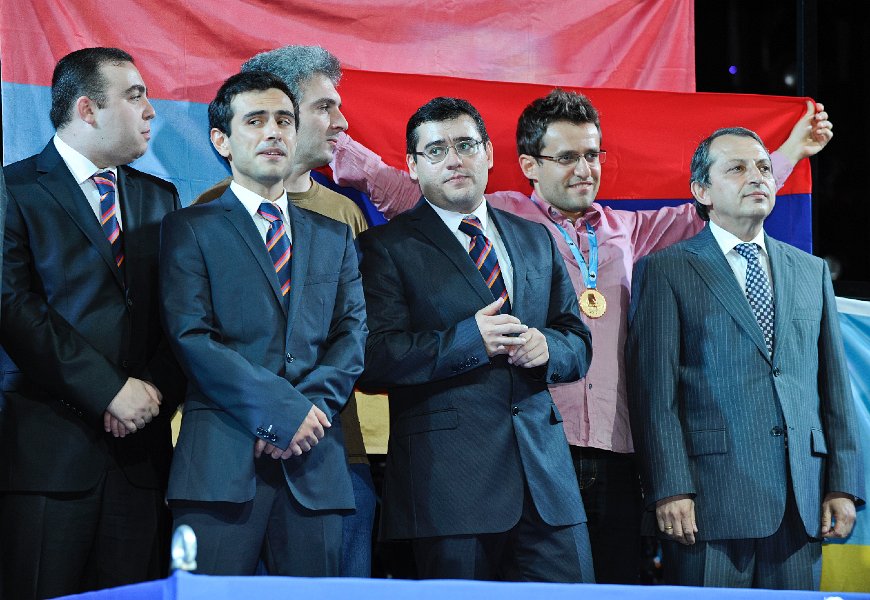On Sunday, Armenia won the gold medal at the 40th Chess Olympiad in Istanbul. It is their third Olympic gold overall. They also finished first at the World Team Championship last year in Ningbo, China.
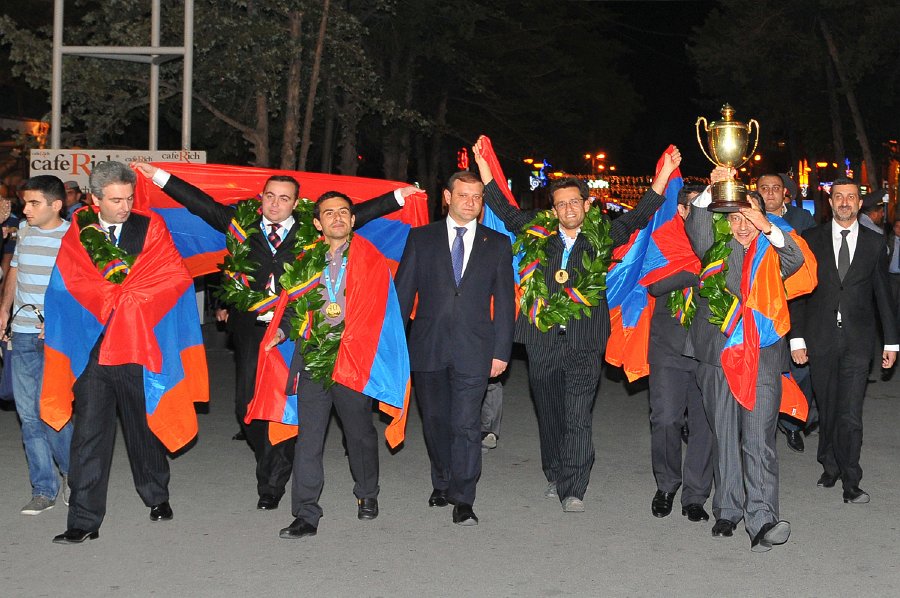
Upon arrival in Yerevan on Monday, the jubilant Armenian chess team was treated like national heroes by a cheering crowd and the president of Armenia Serzh Sargsyan who is also the head of the Armenian Chess Federation. Small countries do that. They cherish their victories. The Czech national ice-hockey team, led by Dominik Hasek and Jaromir Jagr, got a similar reception after they returned to Prague from the 1998 Winter Olympics in Nagano with a gold medal.
Ideally, to win medals at chess Olympiads, the team should not lose a match. But nobody went undefeated in the 11-round event in Istanbul. The outcome was decided not by how teams won their matches, but by the timing of their losses. Every time some teams jumped into the lead, they were knocked out like duck pins. Those who lost earlier could still recover. The drama continued into the last round and when it was over Armenia won nine matches, lost one and tied one. They had the most match points and the best tiebreak.
The final standing: 1. Armenia 19/22, 2. Russia 19, 3. Ukraine 18, 4. China 17, 5. USA 17.
The results are based on match points. Shared places were decided by a tiebreak.
In the Women's Olympiad Russia and China scored 19 points, but the gold went to the Russians on a tiebreak. Ukraine won the bronze with 18 points.
Individually, the Czech GM David Navara scored the most points with 9.5/11. GM Shakhriyar Mamedyarov of Azerbaijan posted the best rating performance with 2880 points and a 8.5/10 score.
Let's ride the olympic roller coaster to see the ups and downs of the top five finishers.
ARMENIA
The winning Armenian team and their final scores. From the left: Tigran Petrosian (2.5/3), Gabriel Sargissian (7/11), Vladimir Akopian (7.5/10), Sergei Movsesian (5/10), Levon Aronian (7/10) and the captain Arshak Petrosian
Armenia beefed up their line-up, acquiring Movsesian from Slovakia for $50,000. He finished with 50 percent on the second board, but delivered the only win against Hungary in the last round.
In the fifth round, Armenia clashed with Ukraine, the defending champions, and their top board Aronian brought home the victory in the Queen's Indian.
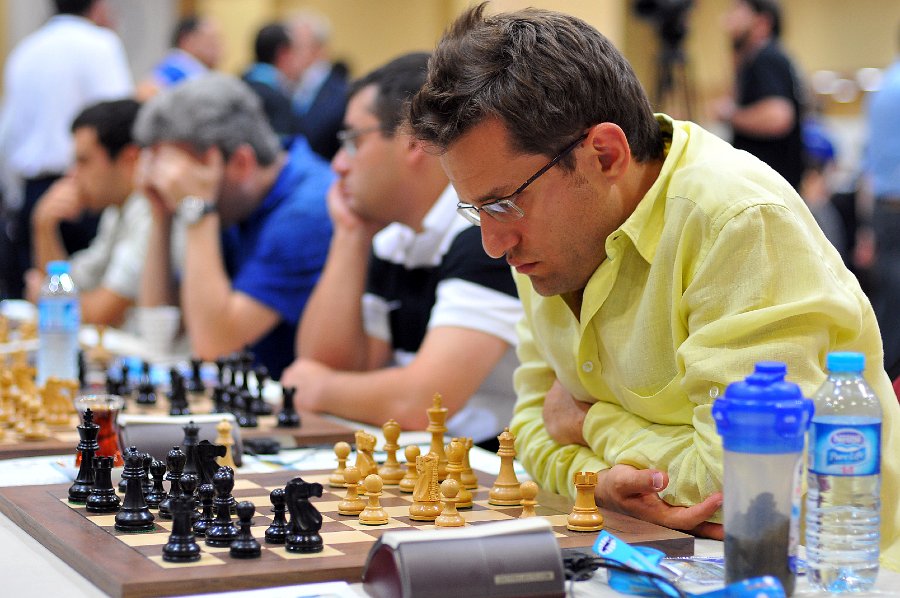
Aronian,Levon - Ivanchuk,Vassily
1.Nf3 Nf6 2.c4 e6 3.d4 b6 4.g3 Ba6
Nimzovich's sharp attacking idea in the Queen's Indian, but even the quiet line 4...Bb7 5.Bg2 Be7 6.0-0 0-0 can be spiced up with a pawn sacrifice 7.d5!? exd5 8.Nh4. The line became popular after the Candidates match Polugaevsky-Korchnoi, Buenos Aires 1980. Aronian played it against Ivanchuk in 2007and the game was drawn.
5.b3 Bb4+ 6.Bd2 Be7 7.Nc3 Bb7 8.Bg2 0-0 9.0-0 Na6 10.d5 exd5 11.Nd4
White doesn't need to place his knight on the rim anymore. After 11.Nh4 Ne4! black is fine.
11...Bc5 12.Nc2 c6 13.cxd5 cxd5 14.Bg5 Nc7 15.Ne3 d4?!
Ivanchuk must have misjudged the complications.
16.Bxb7 Rb8 17.Ng4! dxc3 18.Bxf6 gxf6 19.Be4!
Preparing an invasion along the diagonal b1-h7. The shattered, week pawns can't provide a good cover for the black king.
19...d5 20.Bc2
21.Qd3 is a serious threat.
20...f5 21.Nh6+ Kh8 22.Nxf5 Qf6 23.a3!?
A clever move that threatens to push the dark bishop back with 24.b4. Ivanchuk prevents it, but it allows Aronian's rook to break into black's position.
23...a5 24.Qd3 Rg8
24...Ra8 protects against the invasion, but white is still better after 25.Rfb1 Ne6 26.b4 axb4 27.axb4 Rxa1 28.Rxa1 Bxb4 29.Ne3 Qg7 30.Nxd5.
25.b4!
Opening the a-file for the rook.
25...axb4 26.axb4 Bxb4
After 26...Bf8 27.Ra7 Ne6 28.Ne7! Rg7 29.Nxd5 white should win.
27.Ra7 Ne6 28.Ne7!
After this elegant jump, threatening 29.Qxh7 mate and attacking the rook on g8, black also has to cope with an unpleasant fork 29.Nc6.
28...Qg7 29.Nxg8
White could have taken the other rook: 29.Nc6 Bc5 30.Nxb8 Rxb8 31.Qxd5.
29...Kxg8 30.Qxd5
Aronian is winning and he converts his advantage wonderfully.
30...Bc5 31.e3 b5 32.Ra8 Rxa8 33.Qxa8+ Qf8 34.Qe4 Qh6 35.Ra1 b4 36.Ra5 Bf8 37.Qg4+ Qg7 38.Qh4 h6 39.Ra8 Nc7 40.Rxf8+!
A pretty combination, winning a piece.
40...Qxf8
After 40...Kxf8 41.Qxb4+! Ke8 (41...Kg8 42.Qb8+ wins) 42.Ba4+ Kd8 43.Qb8+ Ke7 44.Qxc7+ white mates soon.
41.Qg4+ Kh8
After 41...Qg7 42.Qc8+ wins.
42.Qf5 Black resigned.
White wins a piece either after 42...Qg8 43.Qe5+; or after 42...Qg7 43.Qc8+.
RUSSIA
The Soviet team won gold at every chess Olympiad from 1954 till 1990 with the exception of 1978 when the Hungarian team edged them in a tiebreak in Buenos Aires. The team of Russia continued the dominance, winning from 1992 till 2002. Ukraine won in 2004 and 2010 and Armenia in 2006 and in 2008. The Russians wanted the gold back.
In the sixth round Russia met Armenia. Although the match ended 2-2, the former world champion Vladimir Kramnik scored a fine win against Aronian.

Kramnik,Vladimir - Aronian,Levon
White was slightly better after 21 moves and black had to find a good defense.
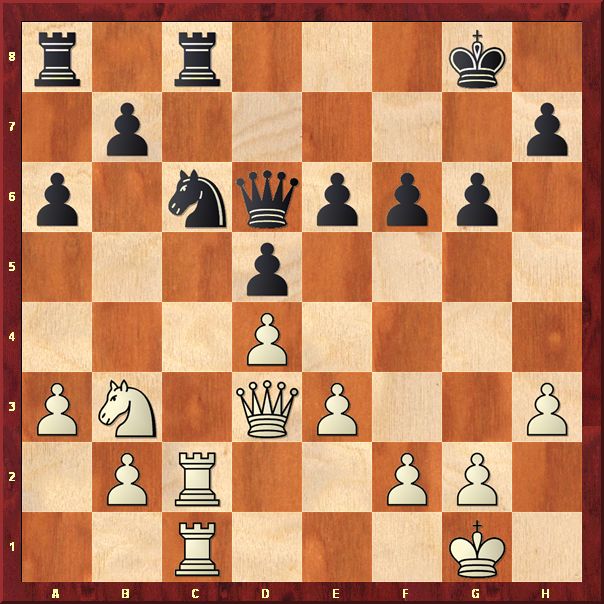
21...Rc7?
Doubling the rooks on the c-file is often a good idea in similar positions, but here it doesn't work. 21...b6 loosens the queenside pawns, but it was an option.
22.Na5! Rac8 23.Nxb7!
A beautiful long-term combination, breaking black's resistance. White will have two pawns for the knight, but black will be tied up. Eventually, white can advance the b-pawn and win the pinned black knight.
23...Rxb7 24.Qxa6 Rbc7 25.b4
Black is caught in terrible crosspins and doesn't have a way out. The threat is 26.b5.
25...Qd7 26.Qb6!
An important move, tying up black's pieces.
26...Qe8
The pinning continues in the variation: 26...Rb8 27.Qxb8+! Nxb8 28.Rxc7 Qd6 29.Rb7 Nd7 30.Rc8+ Kg7 31.Rd8 and the open seventh rank is a bad omen for black.
27.b5 Nxd4 28.Rxc7 Ne2+ 29.Kh1 Nxc1 30.Rxc8 Qxc8 31.Qc6!
The double-attack wins the knight, but Kramnik is more interested in promoting the b-pawn.
31...Qd8 32.b6 Kf7 33.Qc7+ Ke8 34.Qa7 d4 35.b7 Black resigned.
After China defeated the Armenians in the seventh round, Russia took the lead, moving closer to their goal.
USA
The previous matches between the Soviets and the Americans were always exciting and the US team didn't come out of it empty-handed. I was still playing on the team when we beat the Soviets in 1984 and in 1986. The younger Americans scored victory over Russia in 2006. With great performances on the top two boards, they beat the Russians again in Istanbul and with two rounds to go shared the lead with Russia, Armenia and China.
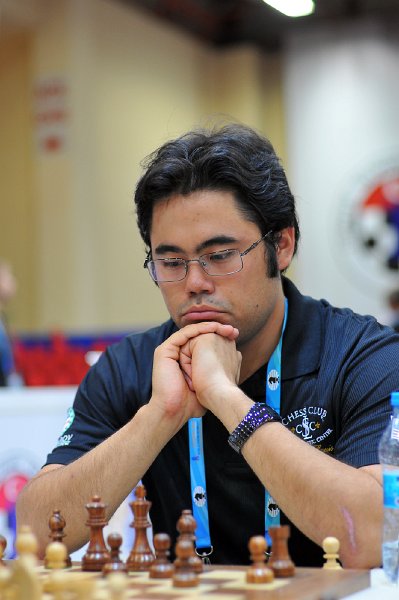
Hikaru Nakamura surpassed Bobby Fischer's rating record of 2785 in Istanbul. Hikaru showed great fighting spirit and his 6 points in 9 games was one of the top results on the first board. He took considerable risks in defeating Kramnik.

Nakamura,Hikaru - Kramnik,Vladimir
Nakamura played well against Kramnik in the past, defeating the former world champion a few times. Instead of taking a draw by repetition earlier in this game, Hikaru deliberately went into a worse position, but later outplayed the Russian. After 60 moves they reached this position:
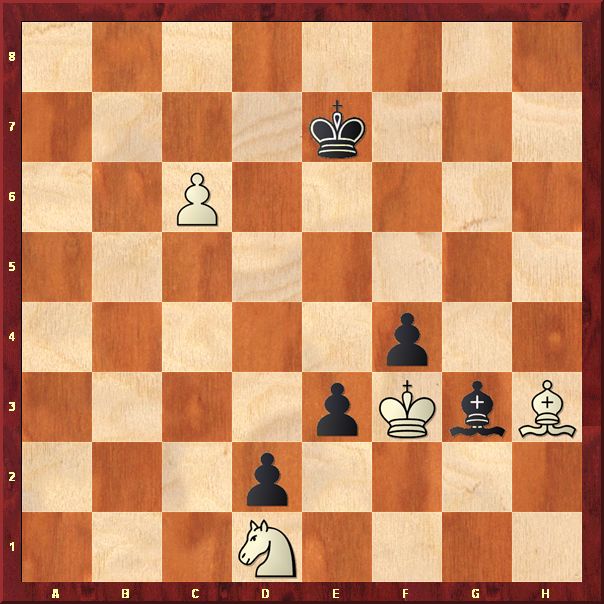
61.c7 e2 62.c8N+!
Not 62.Kxe2 f3+ 63.Kxf3 Bxc7 and black draws.
32...Kf6 63.Kxe2
Nakamura has winning material on the board. He will soon capture the black pawns. Afterwards his bishop will take care of the light squares and one knight will control the dark squares. The other knight and the king will push the black king into a corner and mate him there. The game actuallly came to a quicker end.
63...Ke5 64.Nb6 Kd4 65.Bg2 Be1 66.Nd5 Ke5 67.Nb4 Bh4 68.Nd3+ Kf5 69.Kxd2 Kg4 70.Ke2 Bf6 71.N1f2+ Kg3 72.Bf3 Bd8 73.Ne4+
This knight and the bishop contain the black king. The other knight does the final damage.
73...Kh4 74.Ne5 Bc7 75.Ng6+ Kh3 76.Ne7 Bd8 77.Nf5 Bb6 78.Kf1 Kh2 79.Bg4 f3 80.Nh4
Threatening mate in two with 81.Nxf3+ Kh1 82.Ng3 mate. Black resigned.
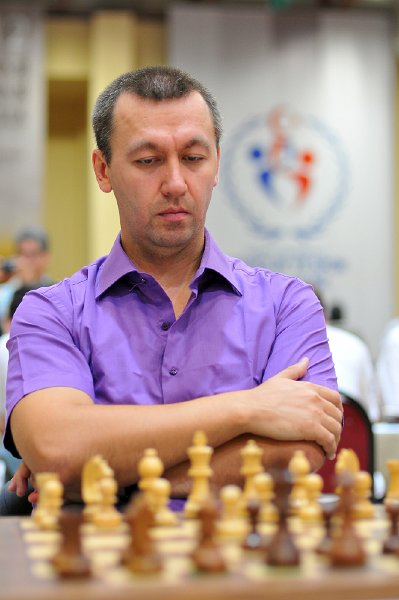
Gata Kamsky's stellar performance (8.5/11) was the best on the team. He outplayed Russia's Alexander Grischuk marvelously, but when he was about to collect the full point, things began to happen.
Grischuk,Alexander - Kamsky,Gata
The endgame was an 18th century saga transferred to modern times with wonderful tricks and trades. Kamsky played a great technical game and should have won it. Instead, he allowed Grischuk to escape. With a draw in sight, the Russian slipped, proving that this endgame is difficult to defend even for the best players. The drama begins after 45 moves:
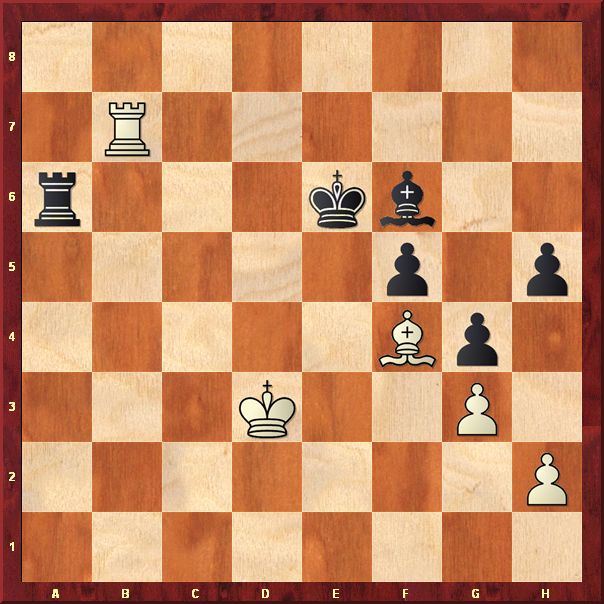
46.Rh7 Ra3+ 47.Ke2
After 47.Kc4 comes 47...h4.
47...Ra2+ 48.Kf1 Kd5?
Kamsky is cutting it too close. Black should have played 48...Rxh2! 49.Kg1 Rh3 50.Rh6 Kf7 51.Rh7+ Kg6 52.Rb7 h4 53.Rb6 Rxg3+! 54.Bxg3 hxg3 and he would not have any problems to roll his pawns forward.
49.Rxh5 Ke4 50.h3 gxh3
After 50...Kf3 51.Rxf5 Ra1+ 52.Bc1+ Kxg3 53.hxg4! draws.
51.Rxh3 Bd4 52.Rh5 Rf2+ 53.Ke1 Rg2 54.Kf1 Kf3
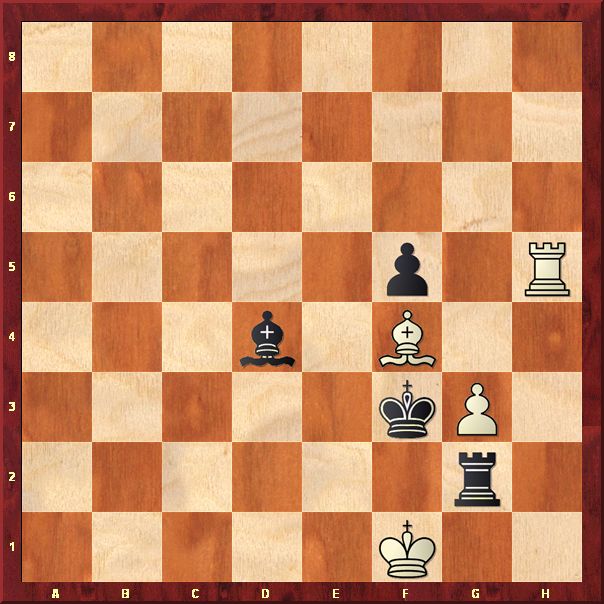
55.Be3!?
Grischuk tries to force a draw brilliantly. It was possible to play: 55.Ke1 Bf2+ 56.Kd1 Bxg3 57.Bxg3 Kg4 58.Rxf5! and white draws.
55...Bxe3 56.Rxf5+ Kxg3 57.Re5 Rf2+ 58.Ke1 Kf4
The rook and bishop vs. rook endgame with the king of the weaker side on the last rank was analyzed already in the 18th century. The winning methods were shown by the Italian master and theoretician Giambattista Lolli in 1763 and by the Frenchman André Danican Philidor in 1792. With a correct play, the weaker side may draw, but many games were lost during actual tournament play.
59.Re8
The best, according to the endgame tablebase, was to stay on the 5th rank, for example 59.Rh5.
59...Ra2 60.Kd1 Kf3 61.Re7?
Grischuk slips and makes a losing move. The endgame tablebase gives three moves to make a draw: 61.Rd8, 61.Rh8 and 61.Rf8+.
61...Rd2+ 62.Ke1 Rd8! 63.Rf7+ Bf4 64.Rf6
This is where Phillidor wanted the rook to be. Black also wins after 64.Rf5 Re8+! 65.Kd1 Rc8, threatening 66...Rc1 mate.
64...Rc8!
The final coup, threatening 65...Rc1 mate. The saving move 65.Rd6 is denied by the bishop.
White resigned.
In the next round the U.S. team faltered and lost to China, but they fought back and beat Poland in the last round.
"Objectively, sharing the place with China was a better result than the bronze medal results in Turin and Dresden." says John Donaldson, the captain of the U.S. team. "We started well and were always within sight of the leaders. With a bit more luck we could have medaled."
The rest of the team performed well: Alexander Onischuk (6.5/10), Varuzhan Akobian (3.5/6), Ray Robson (5.5/8).
CHINA
The Chinese lost to Russia, but defeated the Armenians. With the victory over the Americans China leaped into a shared lead. They had the best tiebreak and a victory in the last round would have earned them the gold medals. But Ukraine smashed them 3-1 and took them out of medal contention.
UKRAINE
The defending champion lost matches against Russia and Armenia. Getting the bronz was considered a miracle, but the Ukrainians managed to do it. Ivanchuk downed Wang Hao in the last round with a nifty combination.
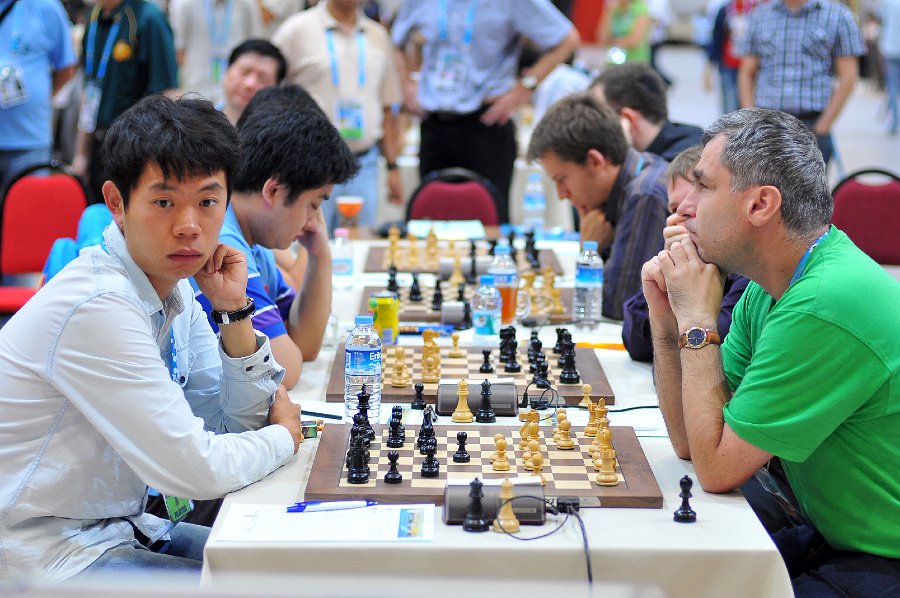
Ivanchuk,Vassily - Wang,Hao
1.d4 Nf6 2.c4 e6 3.Nc3 Bb4 4.e3 0-0 5.Bd3 d5 6.Nf3 b6 7.a3 Bxc3+ 8.bxc3 c6!?
The point of this novelty is clear and simple: anytime white captures on d5, black would take back with his c-pawn. It opens the c-file and allows black to pressure the backward pawn on c3. The immediate 8...Ba6 had some success after 9.cxd5 Bxd3 10.Qxd3 Qxd5.
9.cxd5 cxd5 10.Qe2 Nc6 11.0-0 Na5 12.a4 Re8 13.Ne5 Ne4 14.f3 Nd6
After 14...Nxc3? 15.Qc2 wins.
15.Ba3 Bb7 16.Bxd6 Qxd6 17.f4
White fortifies the Pillsbury knight on e5. This attacking set-up was used by the talented American Harry Nelson Pillsbury (1872-1906). White only needs to lift his heavy pieces into attack.
17...g6
Weakens the dark squares, but black had to prevent the bishop sacrifice on h7, for example 17...Rac8? 18.Bxh7+! Kxh7 19.Qh5+ Kg8 20.Qxf7+ Kh7 21.Rf3 and white mates.
After 17...h6 18.Qh5, followed by f4-f5, white's attack is too powerful.
18.Qg4 Nc4 19.Qg3 Qc7 20.Bxc4 dxc4
Ivanchuk will now open the f-file.
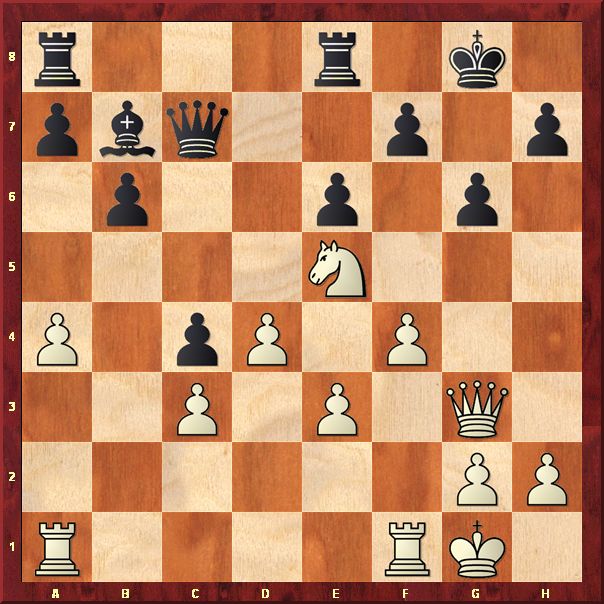
21.f5! f6?
Allowing a pretty finale. But after 21...exf5 22.Rxf5 Bd5 23.Raf1 Be6 24.Rf6 white has a complete command of the dark squares. Black has no counterplay and white's attack grows with each new move.
22.fxg6!
The combination, sacrificing the knight and rook, wins easily. Ivanchuk had only to calculate properly.
22...fxe5 23.Rf7 Qc6 24.gxh7+!
Sacrificing the rook, Ivanchuk concludes the game with a king's hunt.
24...Kxf7 25.Rf1+ Ke7 26.h8Q!
A powerful deflection, preventing the black king from hiding on the eighth rank.
26...Rxh8 27.Qg7+ Kd6
After 27...Kd8 28.Qxh8+ Kc7 (or 28...Qe8 29.Rf8 wins.) 29.Rf7+ Kd6 30.Qxe5 mates.
28.dxe5+ Kd5
Black gave up at the same time. White wins after 29.Rd1+ Ke4 (or 29...Kc5 30.Qe7+) 30.Qg5, mating on the next move.
Black resigned.
For the record, 157 teams participated in Istanbul. The Women's Olympiad had 127 teams.
Note that in the replay windows below you can click either on the arrows under the diagram or on the notation to follow the game.
Images by Arman Karakhanyan and David Llada

